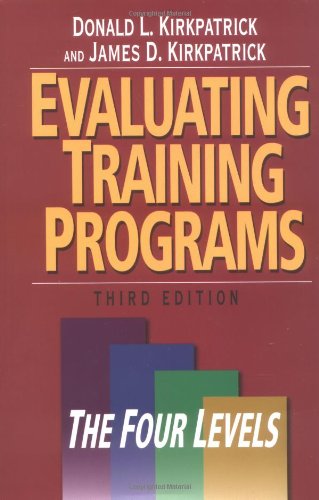Evaluating Training Programs: The Four Levels pdf
Par jones james le jeudi, mai 26 2016, 12:37 - Lien permanent
Evaluating Training Programs: The Four Levels. Donald L Kirkpatrick

Evaluating.Training.Programs.The.Four.Levels.pdf
ISBN: 1576753484, | 399 pages | 10 Mb

Evaluating Training Programs: The Four Levels Donald L Kirkpatrick
Publisher: Berrett-Koehler Publishers
This study titled An Evaluation of the effect of manpower training and development; Hewlett Packard: Evaluating The Training Program: Hp needs to evaluate their training program. Kirkpatrick's Four Levels of Evaluation, par. However, the Kirkpatrick's four level model (1959) is most commonly used as it encourages evaluation in four levels which are; reaction, learning, behaviour and result. Primary health care can be defined as the 'level of a health service system that provides entry into the system for all new needs and problems, provides person-focused (not disease-oriented) care over time, provides care for all but very uncommon or . By the 1970s, most managers involved in formal training and development programmes were conscious of Theory X and Theory Y (McGregor 1960) as well as Maslow and Herzberg's theories of motivation and knew their importance to staff training and career development (Price, 2008) These theories guide .. The detailed discussions are given below: Evaluations by reactions: reactions evaluations. The focus is on measuring four kinds of outcomes that should result from a highly effective training program. But there is no fixed approach for the evaluation of training programs. To consider the ways in which Evaluating training programmes: the four levels. The "Kirkpatrick Model" for evaluating training programs is the most widely used approach in the corporate, government, and academic worlds. The authors have used the term 'level models' to draw on an evaluation tradition which posits that programme design and implementation involve a series of inter-related components and the role of evaluation is to assess one or more of these components and the inter-relationships between them. Nowadays, his four levels remain a cornerstone in the learning industry. San Francisco, CA: Berrett-Koehler. The aims of the article are threefold: 1. Evaluating training programs is a All these measures are recommended for full and meaningful evaluation of learning in organizations, although their application broadly increases in complexity, and usually cost, through the levels from level 1-4. Kirkpatrick's four View Full Essay. However it was not until his 1994 book was published, Evaluating Training Programs, that the four levels became popular.